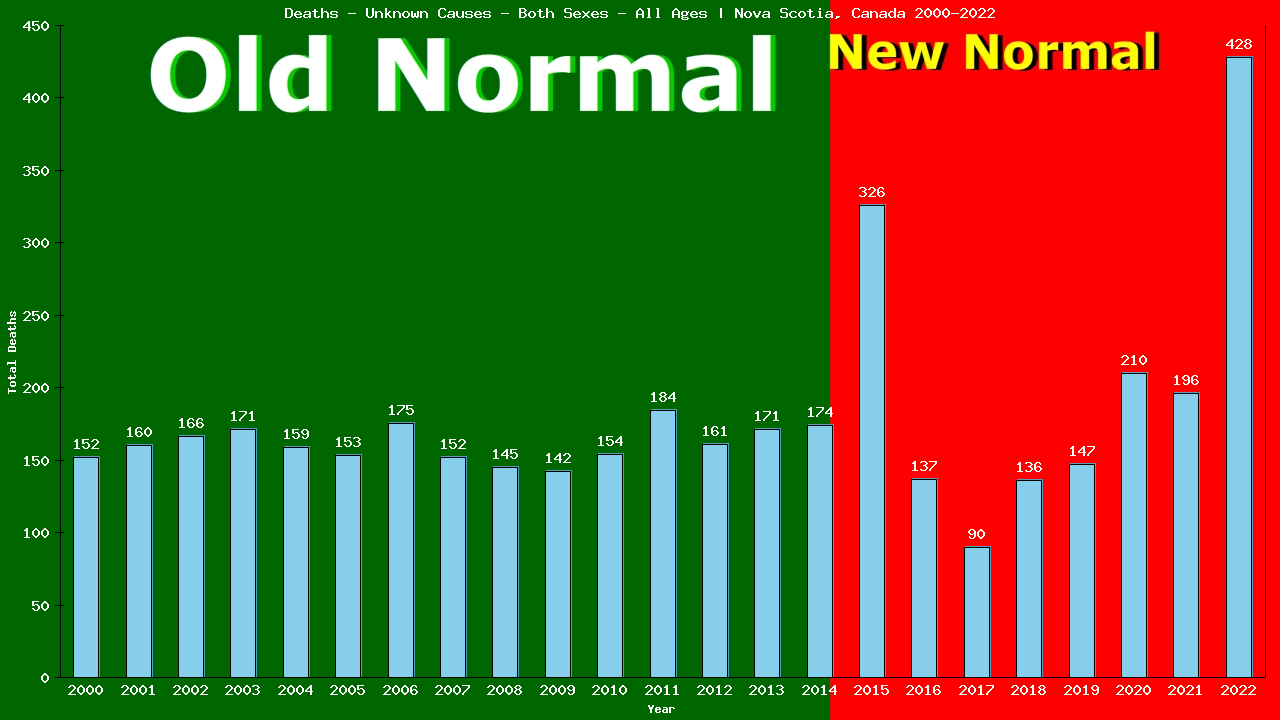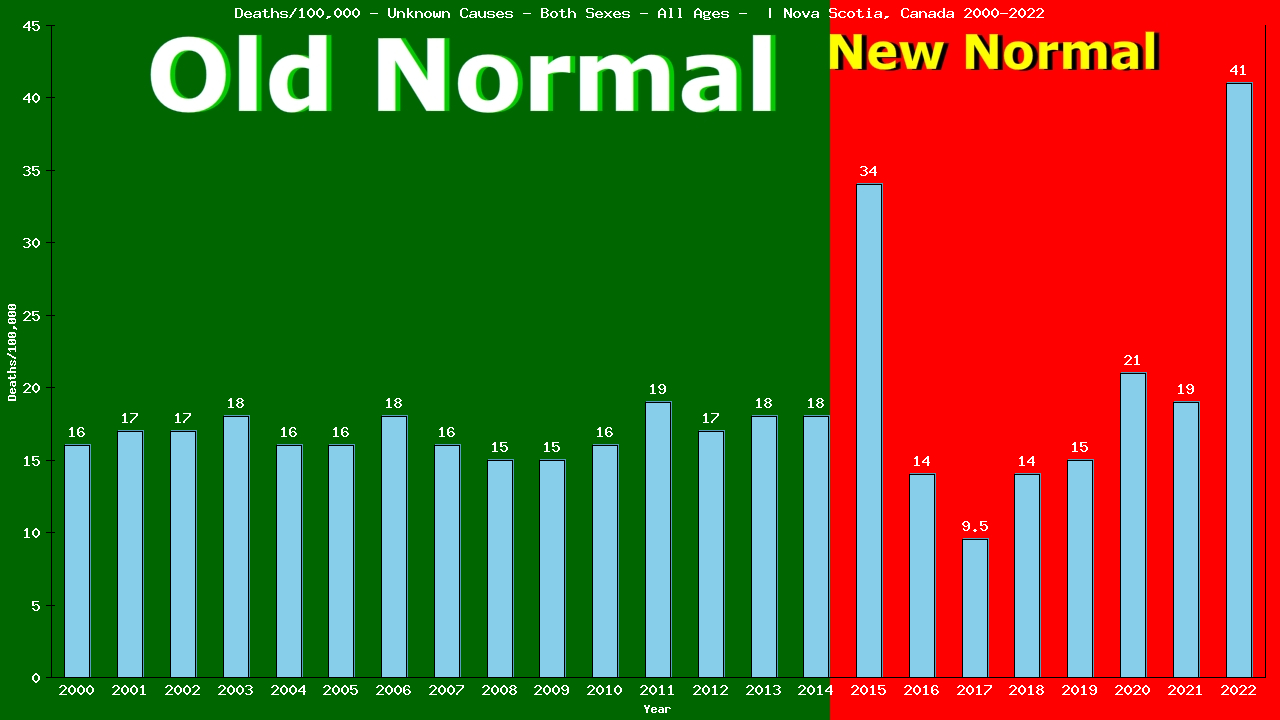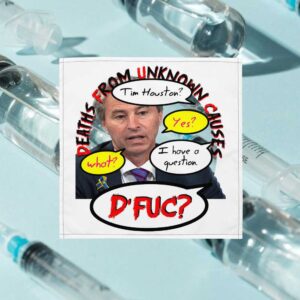Excess Deaths
- References
- Deaths: Government of Canada
- Population: Government of Canada
- Nova Scotia provided All-age Unknown Causes data from 2014-2022
- Age-categorized data extrapolated from Canada data
- 2001-2013 Unknown Causes deaths extrapolated from Canadian data
Quick Links
- There were a total of 11,403 deaths in Nova Scotia in 2022
- 428 of all deaths were from Unknown Causes
428 deaths from Unknown Causes were among individuals of all ages
2022 vs New Normal™ for individuals of all ages in Nova Scotia
- 428 of 11,403 total deaths were from Unknown Causes
- 3.75% of all deaths were from Unknown Causes
- This is up 130% compared to Old Normal rates.
- 176 of 8,975 total deaths would have been expected under Old Normal conditions.
- 252 excess deaths from Unknown Causes in 2022.
- 2,428 excess All Cause deaths in 2022.
- 333 excess deaths from Unknown Causes (2015-2022)
- 10,448 excess All Cause deaths over the first 8 years of Nova Scotia’s New Normal™.
- To show this year’s deaths from Unknown Causes are up 130% compared to Old Normal rates, we need to calculate the rates for both 2022 and for the Old Normal.
Remember, death rates are calculated to answer these questions:
- “How many individuals of all ages were there?” and
- “How many of them died from Unknown Causes?”
The following 2 charts provide this information:
Deaths – Unknown Causes – Both Sexes – Of All Ages | Nova Scotia, Canada

Population – Both Sexes – Of All Ages – [2001-2022] | Nova Scotia, Canada
![Graph showing Population - Both Sexes - Of All Ages - [2001-2022] | Nova Scotia, Canada](/wp-content/plugins/dfuc-display/charts/canada/nova-scotia/2022/all/Both Sexes/GrandTotal-pop.png)
From the charts, we can see that in 2022, 428 of 1,019,725 individuals of all ages living in Nova Scotia died from Unknown Causes.
428 ÷ 1,019,725 = 0.00042 (2022 CDR)
The table shows there were a total of 2,267 deaths from Unknown Causes among 13,139,077 individuals of all ages living in Nova Scotia in the 14 years immediately prior to the New Normal™.
2,267 ÷ 13,139,077 = 0.00017 (Old Normal CDR)
We can use the Old Normal rate to predict this year’s deaths:
2022 pop X Old Normal CDR = expected deaths
1,019,725 X 0.00017 = 176 expected deaths
The difference between actual and expected deaths shows lives saved or lost:
428 – 176 = 252
Dividing the actual deaths by the expected deaths gives us the comparative rates:
428 ÷ 176 = 2.2994
This reveals 252 lives lost and is 229.94% of what we expected (an increase of 130%) in deaths from Unknown Causes among individuals of all ages living in Nova Scotia in 2022, as compared to the Old Normal.
This is the same method used by Public Health to calculate the 5-yr CDR (Cumulative Death Rate):
1,242 ÷ 6,730,880 = 0.00018 (5-yr CDR)
1,019,725(2022 pop) X 0.00018 = 188 expected deaths
The difference between actual and expected deaths:
428 – 188 = 240 or 240 lives lost
Divide actual deaths by expected deaths:
428 ÷ 188 = 2.1577 or an increase of 116%
for deaths from Unknown Causes among individuals of all ages living in Nova Scotia in 2022, as compared to the previous 5 years.
Compare our Old Normal to the 5yr CDR. Does it tell the same story your TV does?
Finally, the same method can also be used to compare our Old Normal rate to the New Normal™ rate:
New Normal™ population X Old Normal rate = expected deaths
7,750,605 X 0.00017 = 1,337 expected deaths
The difference between actual and expected deaths:
1670 – 1,337 = 333 or 333 lives lost
Dividing the actual deaths by the expected deaths:
1,670 ÷ 1,337 = 1.1804 or an increase of 18%
in deaths from Unknown Causes among individuals of all ages living in Nova Scotia in the New Normal™, as compared to the Old Normal.
The world has been led to believe that a deadly pandemic swept the globe beginning in 2020, causing an increase in death rates, especially among the elderly
The data show that death rates began to increase in 2015, immediately upon implementation of the UN’s 2030 Agenda for Sustainable Development, that young adults have experienced ever-increasing death rates since, and that death rates among the elderly have remained relatively stable.
Return to the top of the page to select another age category.
Deaths/100,000 both sexes GrandTotal from Unknown Causes

×









